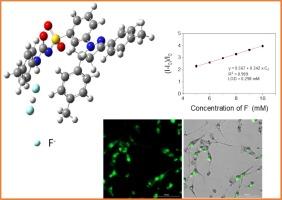用于活细胞中氟离子的抗增殖活性、检测和成像的新型磺酰脲类荧光探针
IF 4.9
2区 化学
Q1 CHEMISTRY, ANALYTICAL
引用次数: 0
摘要
本研究合成了四种新型三苯基吡唑啉-4-甲苯磺酰脲(PYSUs),以开发潜在的抗癌药物和用于检测 F 离子的荧光探针。这些化合物是通过两步微波辅助法合成的。PYSUs的抗增殖活性针对两种癌细胞系进行了测试:HepG2 和 MDA-MB-231。在这些化合物中,3a 对这两种细胞株都有很强的活性,而 3b 对 MDA-MB-231 细胞有很强的活性,但对 HepG2 细胞的抑制作用较弱。此外,化合物 3b 被确定为最佳荧光探针,在四丁基氟化铵(TBAF)中的 F- 离子存在时,其发射强度会增加。在二甲基亚砜中,发射波长为 518 纳米(绿色),激发波长为 469 纳米。在 5-10 毫摩尔的线性范围内,检测限(LOD)为 0.269 毫摩尔。通过 DFT/TDDFT 计算,进一步探讨了 F 离子与化合物 3b 之间的相互作用机制。此外,TBAF 培养的 MDA-MB-231 和 HepG2 细胞的荧光成像证实了PYSUs 作为 F- 离子荧光传感器在活癌细胞中的潜力。本文章由计算机程序翻译,如有差异,请以英文原文为准。

Novel sulfonylurea fluorescence probes for antiproliferative activity, detection and imaging of fluoride ions in living cells
In this study, four novel triphenylpyrazoline 4-toluenesulfonylureas (PYSUs) were synthesized to develop potential anticancer drugs and fluorescent probes for the detection of F− ions. The compounds were synthesized via a two-step microwave-assisted method. The antiproliferative activity of the PYSUs was tested against two cancer cell lines: HepG2 and MDA-MB-231. Among the compounds, 3a exhibited strong activity against both cell lines, while 3b showed strong activity against MDA-MB-231 cells but weaker inhibition of HepG2 cells. Furthermore, compound 3b was identified as the best fluorescent probe, with an increase in emission intensity in the presence of F− ions from tetrabutylammonium fluoride (TBAF). In DMSO, the emission wavelength was found to be 518 nm (green) with an excitation wavelength of 469 nm. The limit of detection (LOD) was calculated to be 0.269 mM in the linear range of 5–10 mM. The interaction mechanism between F− ions and compound 3b was further explored via DFT/TDDFT calculations. Additionally, fluorescent imaging of TBAF-incubated MDA-MB-231 and HepG2 cells confirmed the potential of PYSUs as fluorescent sensors for F− ions in living cancer cells.
求助全文
通过发布文献求助,成功后即可免费获取论文全文。
去求助
来源期刊

Microchemical Journal
化学-分析化学
CiteScore
8.70
自引率
8.30%
发文量
1131
审稿时长
1.9 months
期刊介绍:
The Microchemical Journal is a peer reviewed journal devoted to all aspects and phases of analytical chemistry and chemical analysis. The Microchemical Journal publishes articles which are at the forefront of modern analytical chemistry and cover innovations in the techniques to the finest possible limits. This includes fundamental aspects, instrumentation, new developments, innovative and novel methods and applications including environmental and clinical field.
Traditional classical analytical methods such as spectrophotometry and titrimetry as well as established instrumentation methods such as flame and graphite furnace atomic absorption spectrometry, gas chromatography, and modified glassy or carbon electrode electrochemical methods will be considered, provided they show significant improvements and novelty compared to the established methods.
 求助内容:
求助内容: 应助结果提醒方式:
应助结果提醒方式:


